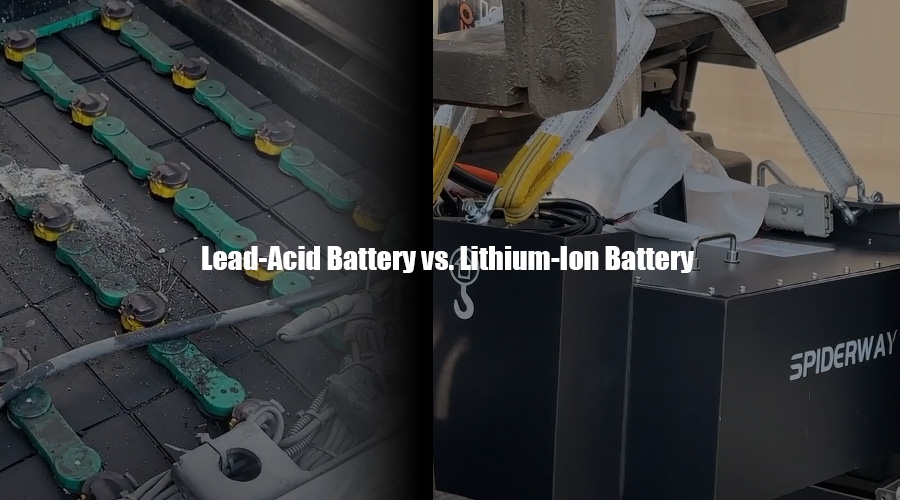
Forklifts are essential in industries worldwide, and their power sources have seen significant evolution. Traditionally powered by lead-acid batteries, many forklift models are now transitioning to lithium batteries. This article explores the primary lead-acid battery models used globally, the advantages of lithium battery upgrades, and SPIDERWAY's innovative LFP forklift battery solutions.
Popular Lead-Acid Battery Models for Forklifts Globally
Electric forklifts rely on lead-acid batteries for steady power delivery. Below are the prominent models used across major brands.
Jungheinrich Forklifts
- Common Lead-Acid Models:
- 24V 3 PzS 465 Ah
- 48V 5 PzS 775 Ah
- 80V 6 PzS 930 Ah
- Applications: Ideal for indoor operations like warehouses.
Toyota Material Handling
- Common Lead-Acid Models:
- 48V 5 PzB 600 Ah
- 80V 6 PzB 800 Ah
- Applications: Widely used for both light-duty and heavy-duty tasks.
Crown Equipment Corporation
- Common Lead-Acid Models:
- 24V 2 PzS 375 Ah
- 48V 4 PzS 620 Ah
- Applications: Known for endurance in demanding environments.
Hyster-Yale Group
- Common Lead-Acid Models:
- 36V 4 PzS 560 Ah
- 48V 5 PzS 700 Ah
- Applications: Frequently employed in logistics hubs.
Mitsubishi Logisnext
- Common Lead-Acid Models:
- 24V 3 PzS 500 Ah
- 48V 4 PzS 800 Ah
- Applications: Ideal for small- to medium-scale operations.
Lead-Acid vs. Lithium Forklift Batteries: A Comparative Overview
Transitioning from lead-acid to lithium batteries offers transformative benefits. Here’s a detailed comparison to help you understand the advantages.
| Aspect | Lead-Acid Batteries | Lithium Batteries |
|---|---|---|
| Energy Density | Low energy density, requiring larger sizes. | High energy density, compact and powerful. |
| Maintenance | Requires regular watering and equalization. | Maintenance-free. |
| Charging Time | 6-8 hours for a full charge. | 1-3 hours, with opportunity charging. |
| Lifespan | 1,000-1,500 cycles. | 2,500-4,000 cycles, doubling efficiency. |
| Environmental Impact | High due to hazardous materials. | Eco-friendly and recyclable. |
| Performance | Declines over time with intensive use. | Consistent power delivery throughout life. |
Why Upgrade Forklift Batteries to Lithium?
The benefits of upgrading to lithium batteries extend beyond operational efficiency.
Increased Productivity
Lithium batteries support opportunity charging, meaning forklifts can be charged during breaks, minimizing downtime and maximizing operational hours.
Cost Efficiency
Despite higher upfront costs, lithium batteries offer a lower total cost of ownership due to longer lifespans and reduced maintenance requirements.
Improved Workplace Safety
Lithium batteries eliminate the need for handling acid, reducing risks of spills and exposure. Their enclosed designs also prevent gassing.
Eco-Friendly Operations
Lithium-ion technology aligns with global sustainability goals, offering recyclable components and reduced environmental footprints.
SPIDERWAY LFP Forklift Lithium Battery Solutions
SPIDERWAY is a leader in lithium battery innovations, offering tailored solutions for the forklift industry. Their LFP (Lithium Iron Phosphate) batteries are specifically designed to replace lead-acid models, ensuring seamless integration and superior performance.
Key Features of SPIDERWAY LFP Batteries
- Custom Fit Designs: Compatible with all major forklift brands.
- Fast Charging: Charges fully within 1-2 hours, enabling round-the-clock operations.
- Safety Assurance: Equipped with advanced Battery Management Systems (BMS) for thermal regulation and overcharge protection.
- Durability: Engineered to endure extreme temperatures and rugged industrial conditions.
SPIDERWAY’s Turnkey Lead-Acid to Lithium Conversion
SPIDERWAY offers a comprehensive conversion package that includes:
- Battery replacement with optimal LFP models.
- Installation of compatible chargers.
- Post-installation support for smooth transitions.





Steps to Upgrade Forklift Batteries
Switching to lithium involves a straightforward process with SPIDERWAY:
- Assessment: Evaluate existing forklift specifications and usage patterns.
- Battery Selection: Choose an LFP battery model tailored to operational needs.
- Installation: Professional technicians ensure seamless integration.
- Training: Guidance on using lithium batteries effectively.
FAQs
What is the lifespan difference between lead-acid and lithium batteries? Lithium batteries last 2,500-4,000 cycles compared to lead-acid's 1,000-1,500 cycles.
Can lithium batteries replace lead-acid in all forklifts? Yes, SPIDERWAY’s LFP batteries are designed for compatibility with most forklift brands.
Are lithium batteries safer than lead-acid batteries? Lithium batteries are safer, with no risk of acid spills or gassing, and include advanced safety features.
How long does it take to charge a lithium forklift battery? It takes 1-3 hours for a full charge, depending on the model.
Is switching to lithium environmentally beneficial? Absolutely. Lithium batteries are recyclable and have a lower environmental impact compared to lead-acid.
What are the cost implications of upgrading to lithium? Though the upfront cost is higher, the long-term savings from reduced maintenance and longer lifespan make lithium more economical.
Conclusion
Transitioning forklifts from lead-acid to lithium batteries is a game-changing move for efficiency, safety, and sustainability. With SPIDERWAY’s advanced LFP solutions, industries can achieve unparalleled performance and cost savings. Embrace the future of forklift power with SPIDERWAY's lead-acid to lithium conversion solutions.
https://www.spider-way.com/forklift-lead-acid-battery-to-lithium-conversion/?_unique_id=67e5ae581ff86
Comments
Post a Comment